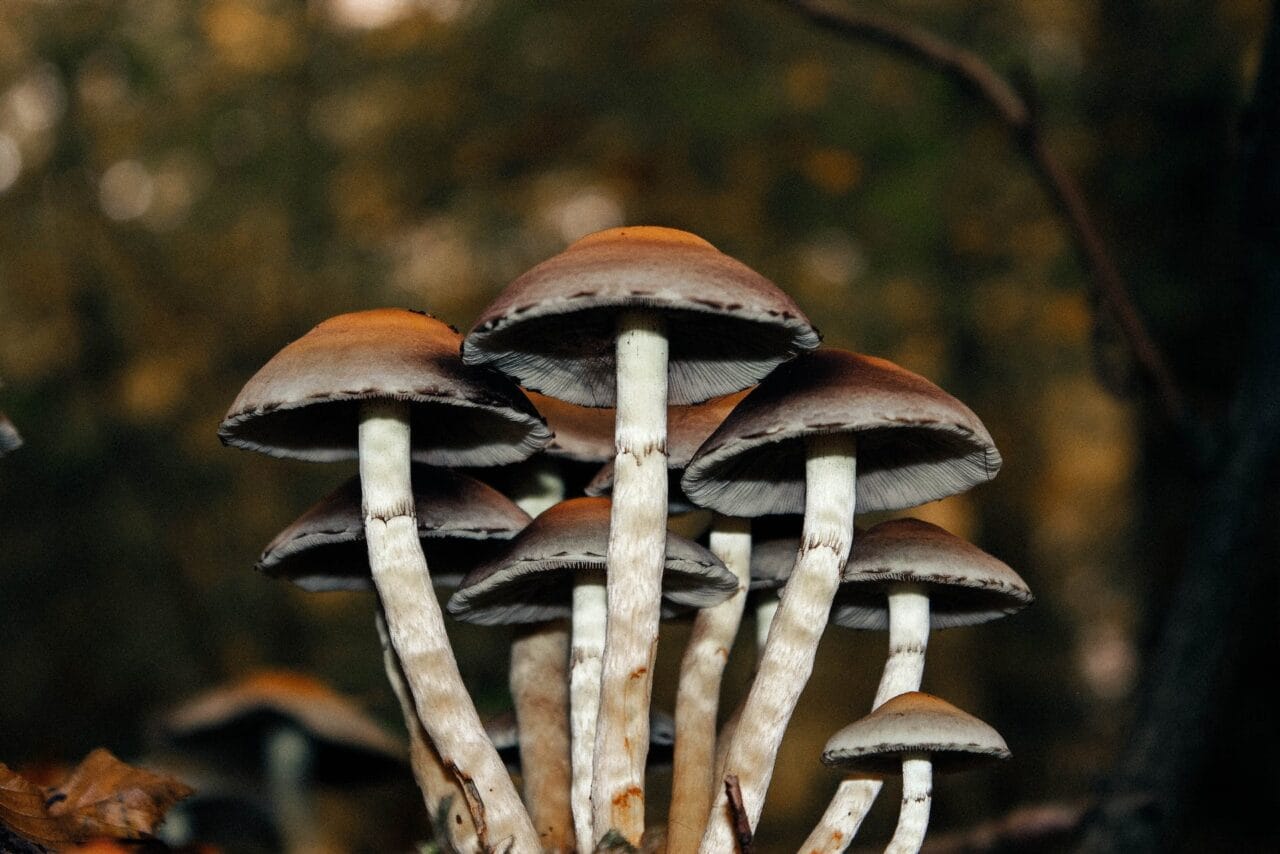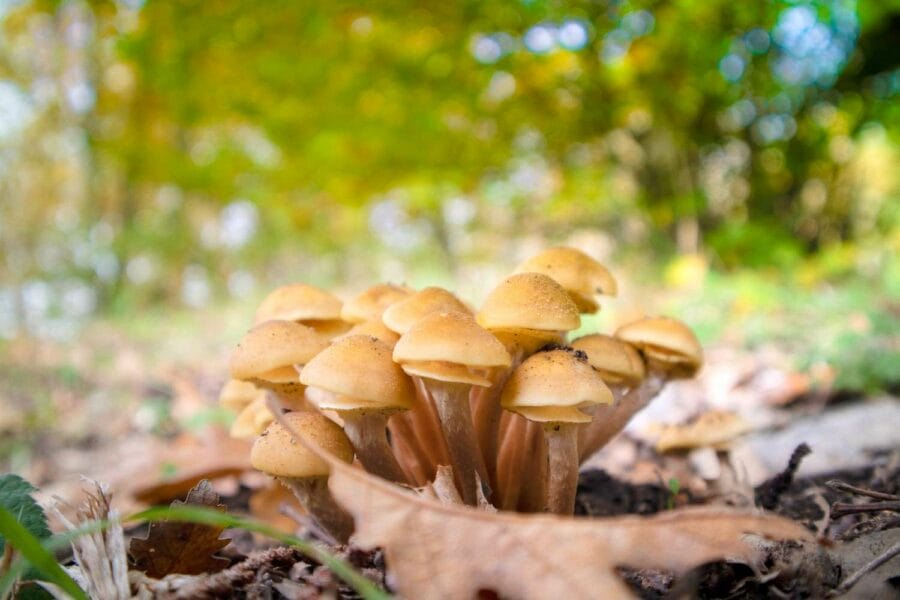Psilocybin, a psychoactive compound found in magic mushrooms, is often used for recreational purposes to induce feelings of euphoria and hallucinations.
Beyond its mind-altering effects, the compound has been researched for its potential benefits in alleviating chronic pain.
This article introduces a case study that investigates the potential of microdosing mushrooms in treating chronic pain.
Key Takeaways:
- Microdosing mushrooms may potentially provide immediate and sustained pain relief.
- Compared to traditional pain medications, microdosing psilocybin generally lacks side effects when used in small quantities.
- Psilocybin interacts with the serotonin 2A (5-HT2A) receptors, which can help mitigate pain, among other conditions.

The Study
The research, “Microdosing Psilocybin for Chronic Pain: A Case Series,” was led by Dr. Matthew Lyes and his team from the Division of Pain Medicine in the Department of Anesthesiology at the University of California, San Diego. The research focused on three patients who self-administered low doses of psilocybin to manage their chronic pain symptoms.
Three Patients, One Outcome – Reduction of Chronic Pain
Patient # 1
| AGE/ GENDER: | 37 Male |
| TYPE OF PAIN: | Neuropathic pain occurring below the site of a spinal cord injury. |
| PAIN LEVEL: | Initially 4 to 5/ 10, increasing to 8/ 10 later in the day |
| PSILOCYBIN DOSE: | 250 mg of ground mushroom for less than 6 months |
| RESULT: | Discontinuation of prescribed pain medication, decrease in muscle spasms, and improved bowel movement efficiency. No signs of rebound pain or withdrawal symptoms. |
| The patient reported that unlike his regular medications that only managed to mitigate the pain, psilocybin effectively eliminated it, decreasing his average pain level from 5 to 0. | |
Case Study Analysis: Subject #2
| AGE/ SEX: | 69-year-old Female |
| PAIN TYPE: | Complex Regional Pain Syndrome (CRPS) |
| PAIN INTENSITY: | Typically between 5 and 7 on a scale of 10, but can increase during physical activity and during pain peaks |
| PSILOCYBIN DOSE: | Regular consumption of 500 mg for 7 to 10 days with breaks (2 to 3 days) over a year. The dosage is increased to between 750 mg and 1 gram during pain peaks |
| EFFECT: | 80% decrease in pain for 3-4 hours, slowly returning to initial levels after 12 hours. Full pain relief (90%-100%) lasts 6-8 hours, reverting to initial levels after 18 hours. |
| The subject observes a reduction in appetite without feelings of nausea. Difficulty in walking or disorientation is reported when the dosage is increased (750 to 1000mg). | |
Case Study Analysis: Subject # 3
| AGE/ SEX: | 40-year-old Female |
| PAIN TYPE: | Lumbar radiculopathy and neuropathic pain |
| PAIN INTENSITY: | Rates an 8 on a scale of 10, but can reach 10 during physical activity |
| PSILOCYBIN DOSE: | Consumes a 1000 mg mushroom chocolate bar bi-monthly. |
| EFFECT: | Significant pain relief without any mind-altering effects. An increase in flexibility and functionality is noted. Pain slowly returns to initial levels over a period of 2-4 weeks. Repeated dosing provides better pain control. |
| The subject does not report any significant physical, cognitive, or behavioural side effects. Her mood remains largely unchanged. She continues her regular dosage of her SSRI for managing depression throughout the psilocybin treatment period. | |
Comprehending Pain Management through Psilocybin
Constant somatic and visceral pain signals strengthen specific neural pathways due to peripheral and central sensitization, resulting in the chronic sensation of pain both physically and emotionally. Psychedelics such as psilocybin stimulate 5-HT2A receptors, potentially resetting the brain regions linked with neuropathic conditions.
A patient reported experiencing pain relief for several weeks. This suggests that direct stimulation of 5-HT2A receptors can lead to a central regulation of pain perception and
Adaptability of synapses.
Possible Side Effects of Psilocybin Compared to Conventional Pain Relievers
| PSILOCYBIN (Based on Studies) | TRADITIONAL PAIN RELIEVERS |
| Muscle spasms | Nausea |
| Decreased appetite | Stomach discomfort |
| Confusion | Headaches |
| Unsteady gait | Dependency |
| No mood changes | Drowsiness |
Potential Areas for Future Psilocybin Research
The research team has identified potential areas of investigation based on the experiences of three individuals, which could have potential benefits.
- Small psilocybin doses could provide immediate and possibly long-lasting neuropathic pain relief, without resulting in physical tolerance or addiction.
- Research the impacts of using different treatment approaches in conjunction with psilocybin. For instance, patient #3 reported an increased pain relief effect when psilocybin was used in combination with physiotherapy.
- Even without psychological therapy, small psilocybin doses may alleviate pain, as shown in this case study. The researchers suggest that combining therapeutic guidance could potentially enhance or extend the therapeutic benefits.
Study Limitations
Despite the encouraging outcomes observed in the patients, it’s critical to keep in mind the limitations acknowledged in the research.
- The limited sample size may not be representative of all individuals experiencing neuropathic pain.
- The study did not include any participants who did not respond to psilocybin.
- There were no assessments performed before and after the treatment to evaluate the effect of psilocybin on mental health conditions like depression and anxiety.
- Most of the information was based on self-reports from the participants.
- The interviewer’s presence and potential biases related to psilocybin could have influenced the participants’ responses.
- The study did not assess the potential impact of the placebo effect.
- The study did not establish the psilocybin quantity in each mushroom.
Microdosing Psilocybin Mushrooms
During the study, patients #1 and #2 consumed a tiny amount of psilocybin, which was in powdered form and derived from dried mushrooms. On the other hand, patient #3 chose to blend it with chocolate. There is a plethora of products specifically designed for psilocybin microdosing. Here are a few of them:
Dehydrated Mushrooms
Although the study didn’t disclose the specific strain used, the one mentioned below is an excellent starting point for novices.
- Golden Teacher: This strain is one of the most prevalent and easily recognizable types of magic mushrooms.
- Amazonian Cubensis: Renowned for its user-friendliness, it can also provide cognitive advantages.
- Cambodian: Microdosing with Cambodian cubensis mushrooms can boost concentration, sociability, and mood.
Psilocybin Microdose Capsules
- Euphoria Psychedelics – Micro Calm Capsules: This concoction includes Ashwagandha, Reishi, CBD, Valerian root, and Psilocybin Mushrooms, all scientifically verified to alleviate anxiety and stress.
- Ground Sounds – Microdose Capsules – Champion Lover: This appealing blend offers three dosage possibilities: 50mg, 100mg, or 250mg of pure psilocybin in combination with reishi, cacao, cordyceps, and maca.
- Kind Stranger – Brighten Capsules 250mg: These capsules are made with the Golden Teacher strain, renowned for fostering clarity, enhanced creativity, and increased focus.
Pain Management with Psilocybin
Although research on mushrooms’ analgesic properties is still in preliminary stages, anecdotal evidence and limited case studies are indicating promising results.
Such instances underscore the need for more extensive research on the potential health benefits of psilocybin. class=”wp-block-list”>
What are the potential risks associated with microdosing?
Microdosing is generally considered safe, but it does have the potential to cause unwanted side effects, such as increased anxiety, disrupted sleep, or the potential for triggering latent psychological issues.
Moreover, microdosing is a relatively new field of study, so the long-term effects are not yet fully understood. It’s always advisable to proceed with caution and consult a healthcare professional if you have any concerns.
Can you microdose with other psychedelics?
While psilocybin is the most commonly used substance for microdosing, other psychedelics like LSD and mescaline are also used by some individuals. However, each substance has its own unique effects and safety profile, so it’s important to research thoroughly before trying a new psychedelic.
Is it legal to microdose with psychedelics?
The legal status of psychedelics varies widely around the world, and even within countries. Therefore, it’s crucial to be aware of and respect your local laws. In some places, certain psychedelics are decriminalized or even legal for medical use, while in others they remain strictly prohibited.
Can microdosing help with addiction?
There is some evidence to suggest that psychedelics, including psilocybin, can be helpful in treating addiction. However, much more research is needed in this area, and individuals struggling with addiction should seek professional help.
Is psilocybin a drug?
Yes, psilocybin is a naturally occurring psychedelic compound produced by certain types of mushrooms. It is often used recreationally for its hallucinogenic effects, but it is also being studied for its potential therapeutic uses, particularly in managing chronic pain.
The widespread acceptance of psilocybin for pain relief is not yet a reality. However, promising findings from case studies inspire hope for those grappling with chronic pain conditions.
Frequently Asked Questions
What effects does microdosing psilocybin produce?
Psilocybin mainly stimulates a serotonin receptor known as “5-HT2A” in the prefrontal cortex, which leads to two primary outcomes:
- The creation of “Brain-Derived Neurotrophic Factor” (BDNF)
- Enhanced “Glutamate” transmission
Besides, psychedelics promote links between brain areas that don’t usually interact. This unusual connectivity is a result of psychedelics’ ability to decrease the activity of the “Default Mode Network” (DMN), which is associated with a range of cognitive functions, including daydreaming, introspection, and reflecting on the past and future.
What is the most notable benefit of microdosing mushrooms?
Microdosing may improve mood, productivity, creativity, and concentration. Its most extensively researched benefit is its influence on mental health.
In November 2022, COMPASS Pathways, a mental health company, disclosed the findings of their thorough phase 2b trial, a randomized and double-blind study. Their investigation suggested that a single psilocybin dose significantly reduced depressive symptoms compared to a placebo. Participants who received a larger 25-milligram dose showed a sustained antidepressant response at the twelve-week follow-up.
A study in the Psychiatry Research Journal found that psilocybin is more effective than traditional antidepressant treatments.
How should you determine your dosage?
Start with a 0.1-gram dose of psilocybin mushrooms on the first day. If you don’t achieve the desired effects, you can gradually increase your dose by 0.05 grams on subsequent microdosing days until you find the optimal level.
People with a history of psychotropic drug use might need to increase the dose to 0.5 grams to get the desired effects.
What precautions should be taken before consuming mushrooms?
- Allocate time to understand your reasons for microdosing on a particular day.
- Set aside a moment for self-reflection and to tune into your current emotional or mental state. Identify the emotions or mindset you believe will be helpful to you that day.
- Once your goals are clearly identified, write them down. Phrasing your objectives as affirmations can significantly support your continuous growth.
- Direct your focus towards the experience you want to create, rather than what you hope to avoid.
- Take it on an empty stomach, preferably an hour before your first meal of the day.
What is the suggested frequency for microdosing mushrooms?
There are several established protocols recommending specific microdosing schedules for psychedelics. These protocols primarily differ based on the number of “off” days they include, which are the days when you abstain from microdosing.
The most commonly advised protocols recommend including 1-3 rest days between microdoses. This aligns with the body’s natural tolerance mechanisms. The three protocols discussed here are the Fadiman Protocol, the Stamets Stack, and intuitive microdosing.




